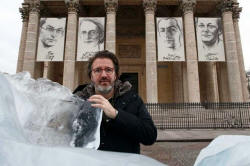|
The ice was scooped from a Greenland fjord and hauled to
Paris as part of an installation by the visual artist Olafur
Eliasson, best known for building waterfalls in New York City in
2008 and an artificial sky inside the Tate Modern gallery in
London in 2003.
"I hope (this) work of art can actually bridge the gap between
the data, the scientists, the politicians and heads of state and
how normal people feel," Eliasson said on Thursday of the
installation, dubbed Ice Watch.
He said he hoped the installation would inspire an ambitious
global deal to curb climate change as negotiators from 195
countries met for a fourth day of the Paris climate summit in
one of the city's northern suburbs.
The ice was pulled from Greenland's Nuuk Fjord and transported
in refrigerated containers by sea to Denmark. It was then
trucked to Paris, where workers in hard hats fork-lifted them
into place Wednesday night. The blocks, some as high as six feet
(2m), drew an audience by Thursday morning as they melted in
front of the 225-year old Pantheon.
"It really shows the connection between human beings and nature,
because this ice’s existence is only temporary, like our
existence," said Kevin Avril, who works nearby and came down for
a closer look at the installation.
Organizers said the project produced about 30 tonnes of carbon
dioxide but did not affect the rapid pace of melting of the huge
Greenland ice sheet that scientists say is a major contributor
to rising sea levels.
(Writing by Richard Valdmanis, editing by Larry King)
[© 2015 Thomson Reuters. All rights
reserved.] Copyright 2015 Reuters. All rights reserved. This material may not be published,
broadcast, rewritten or redistributed. |
|




